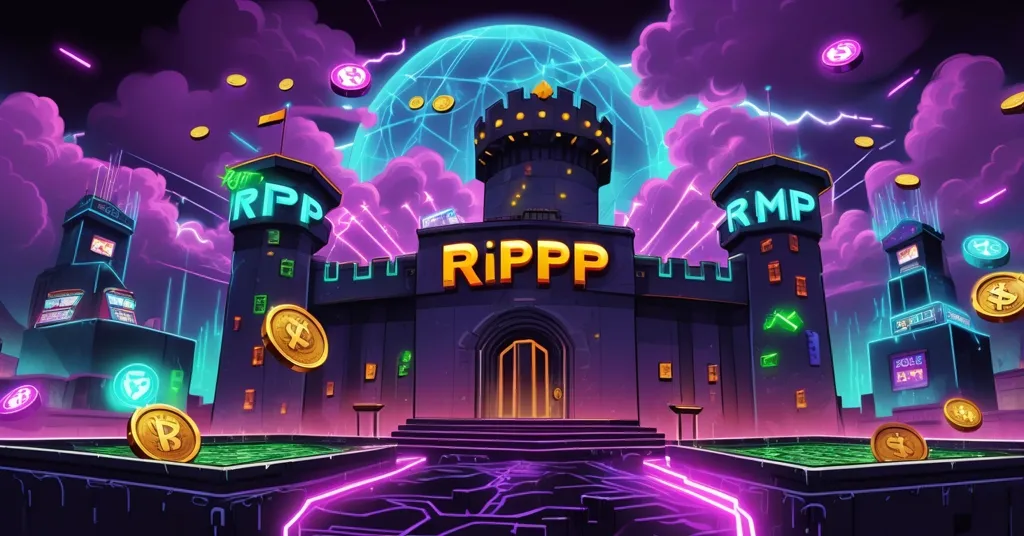Ripple (XRP) Dips Below $2.60 as DeFi Star Mutuum Finance (MUTM) Raises $18M in Presale

Ripple (XRP) Slides Below $2.60 as DeFi Newcomer Mutuum Finance (MUTM) Draws Investor Buzz
Ripple (XRP) has stumbled below the $2.60 threshold, sparking concern among short-term traders, while a Federal Reserve update hints at mixed market signals. Meanwhile, a fresh face in the DeFi arena, Mutuum Finance (MUTM), is grabbing attention with its presale haul of over $18 million, positioning itself as a high-risk, high-reward contender for 2025. Let’s unpack the dynamics of an established altcoin wrestling with volatility and a speculative newcomer promising disruption.
- XRP dips below $2.60, showing relative strength post-Federal Reserve announcement.
- Mutuum Finance (MUTM) raises $18.27 million in presale with a dual-lending DeFi platform.
- Stability versus speculation: Can new DeFi projects outshine battle-tested altcoins?
XRP’s Price Wobble: A Closer Look
The crypto market is no stranger to turbulence, and Ripple (XRP) is caught in the latest storm. Its recent drop below $2.60 has rattled short-term traders, hitting what analysts call “support levels”—price points where a cryptocurrency historically stops falling due to renewed buying interest. Unlike Bitcoin (BTC) and other major assets that took sharper hits following a recent Federal Reserve announcement, XRP’s decline was comparatively mild. This resilience suggests a maturing market perception of its utility, especially in facilitating fast, low-cost cross-border payments through RippleNet, a network often leveraged by financial institutions like Santander. For those new to the space, Ripple differs from Bitcoin’s narrative as a store of value; it’s more akin to a digital bridge for international money transfers, a niche that’s earned it a top spot among altcoins.
Yet, let’s not paint too rosy a picture. While technical analysts murmur about a potential bullish recovery if momentum builds, I’m not here to peddle baseless price predictions or claim XRP will skyrocket to $5 by next week. The hard truth is that XRP remains vulnerable to market volatility and broader economic pressures. Historical data shows XRP has endured wild price swings in the past, often tied to broader crypto sentiment or macroeconomic cues. Add to that the ongoing legal battle with the U.S. Securities and Exchange Commission (SEC) over whether XRP is an unregistered security—a saga that’s dragged on for years—and you’ve got a shadow of uncertainty hanging over investor confidence. Trading volume post-dip has fluctuated, reflecting indecision among holders. XRP’s fundamentals are strong, but it’s far from a safe haven in this wild west of finance. For deeper insights into XRP’s current market challenges, check out this detailed analysis on Ripple’s price movement.
Federal Reserve Fallout: How Macro Events Shake Crypto
Before we pivot to the shiny new kid on the block, let’s dig into why a Federal Reserve announcement even matters to crypto. Central bank signals, like interest rate hikes or dovish hints at stimulus, often ripple through all risk assets—stocks, commodities, and yes, cryptocurrencies. When the Fed tightens policy, investors tend to flee speculative markets like crypto in favor of safer bets like bonds. Conversely, a softer stance can fuel risk-on behavior, pumping up digital assets. In this case, the Fed’s latest update triggered a broader market correction, with Bitcoin taking a notable hit while XRP held up better, suggesting its holders might be less skittish or more tied to its specific use case. Historically, events like the Fed’s 2022 rate hikes crushed crypto valuations across the board, with BTC dropping over 60% from its peak. XRP’s milder reaction this time could signal growing insulation—or just blind luck. Either way, it’s a reminder that crypto isn’t an island; it’s tethered to the same global financial currents as traditional markets, whether we like it or not.
Mutuum Finance: DeFi’s New Contender
While XRP wrestles with market headwinds, a bold new player is turning heads with promises of DeFi disruption. Mutuum Finance (MUTM), currently in Phase 6 of its presale, has raked in over $18.27 million by selling tokens at $0.035, with more than 80% already snapped up. For the uninitiated, DeFi—short for decentralized finance—refers to blockchain-based applications that aim to replace traditional financial intermediaries like banks with peer-driven or automated systems for lending, borrowing, and trading. MUTM is pitching itself as a standout in this crowded space with a dual-lending platform that blends Peer-to-Peer (P2P) and Peer-to-Contract (P2C) models. Imagine lending your crypto directly to another user through P2P for a personal touch, or letting a smart contract—a self-executing agreement coded on the blockchain—handle the deal via P2C for efficiency. This hybrid setup aims to offer flexibility, catering to different risk appetites.
But MUTM isn’t just about lending. They’ve rolled out a buyback mechanism where platform fees generated from transactions are used to repurchase MUTM tokens from the open market and redistribute them to stakers of mtTokens, their native staking asset. The goal? Tie token value to actual usage rather than pure hype—a noble idea in a sector often plagued by empty promises. Without enough users borrowing or lending, there won’t be fees to fuel this system, and the token’s worth could crumble. They’re also gamifying engagement with perks like a $500 daily bonus for top depositors on a 24-hour leaderboard—a nice carrot for whales, but let’s hope it’s not dangling over a cliff. To lower entry barriers, MUTM recently added credit and debit card payments for token purchases, aiming to attract both retail and institutional players. Looking to 2025, a testnet launch on the Sepolia network—an Ethereum testing environment—is slated for Q4, featuring liquidity pools (think communal crypto piggy banks for trading and earning fees), mtTokens, debt tokens, and an auto-liquidator bot to manage bad loans and minimize lender losses. Initially, it’ll support Ethereum (ETH) and Tether (USDT), with plans to expand.
Risk vs. Reward: The Harsh Reality of DeFi Presales
Let’s cut the crap—$18 million raised in a presale sounds impressive, but these early-stage DeFi projects are often a circus of hype. Buyer beware. While MUTM’s ambitious innovations and presale buzz scream high-upside potential, especially with altcoin season—a period when smaller cryptos often outperform Bitcoin—potentially looming in 2025, the risks are glaring. For every DeFi project that becomes a unicorn, countless others implode, leaving investors with worthless tokens. Past cycles have seen notorious rug pulls and failed protocols drain millions from hopeful punters. MUTM’s long-term viability is unproven, and key questions linger: Will enough users adopt the platform to sustain the buyback model? Is the team transparent and capable of delivering on these promises? We don’t have all the answers yet, and that’s a red flag in itself. Compared to XRP, which has real-world partnerships and a tangible use case despite its legal headaches, MUTM feels like a roll of the dice. As champions of decentralization and disruption, we’re intrigued by boundary-pushers like this, but we’re not blind to the pitfalls. Don’t let FOMO cloud your judgment.
XRP and MUTM: Two Sides of the Crypto Coin
Stepping back, the contrast between XRP and MUTM reflects a broader tug-of-war in the crypto space: stability versus speculation. XRP embodies the former—a battle-tested altcoin with a clear mission to streamline global payments, even if it’s not the sexiest story in town. Its partnerships with traditional finance players and focus on utility over hype give it a grounding that many newer tokens lack. MUTM, meanwhile, captures the wild, untamed spirit of innovation that draws so many to DeFi. Its lending experiments and tokenomics aim to carve out a niche in a financial revolution, but it’s a long shot with no track record. Both projects, in their own way, contribute to the ethos of decentralization we hold dear. XRP challenges the inefficiencies of legacy banking, while MUTM pushes the boundaries of what blockchain can do for peer-driven finance. Yet, as Bitcoin maximalists at heart, we can’t help but note that BTC’s unassailable role as digital gold and censorship-resistant money remains the ultimate benchmark. Altcoins and DeFi protocols fill important gaps, but they’re often distractions from the core mission of sound, sovereign currency.
Playing Devil’s Advocate: Are We Building or Bubbling?
Here’s a provocative thought to chew on: Are we truly advancing a financial revolution with projects like MUTM, or just piling on speculative bubbles that could burst spectacularly? Every cycle, the crypto space churns out hundreds of shiny new tokens promising to change the world, only for most to fade into obscurity or worse, scam their backers. While effective accelerationism—pushing tech forward at breakneck speed—is a principle we support, there’s a fine line between innovation and recklessness. DeFi has birthed genuine breakthroughs, like Ethereum’s smart contracts, but it’s also a breeding ground for over-hyped disasters. Even XRP, for all its credibility, isn’t immune to criticism—some argue its centralized tendencies clash with the purist vision of decentralization. As we advocate for freedom, privacy, and disrupting the status quo, we must ask if every new project moves us closer to that goal or simply adds noise to the signal. Bitcoin’s quiet strength reminds us not to lose sight of the original disruptor.
The Bigger Picture: Where Do We Go From Here?
Navigating the crypto landscape is as much about calculated risks as it is about visionary leaps. XRP’s current stumble below $2.60 might be a buying opportunity for the patient, especially if its resilience holds and legal clarity emerges. MUTM’s presale frenzy could mark the rise of the next DeFi darling—or the next big bust. What’s clear is that both reflect broader trends in adoption and experimentation that are shaping the future of finance. As we push for decentralization and a world unshackled from outdated systems, let’s keep our wits about us. Bitcoin remains the bedrock, but the altcoin and DeFi playgrounds are where some of the boldest ideas are tested. Before jumping on the MUTM bandwagon or doubling down on XRP, dig into their whitepapers, track records, and roadmaps. Knowledge is your best defense in this untamed frontier. Stay sharp, stay skeptical, and keep stacking those sats—whatever flavor they may come in.
Key Takeaways and Questions to Ponder
- Why did XRP fall below $2.60, and could it bounce back?
A broader market correction drove the dip, but XRP’s relative strength after a Federal Reserve announcement hints at stability; analysts see potential for a bullish recovery if momentum builds. - What sets Mutuum Finance (MUTM) apart in the DeFi market?
Its dual-lending platform combining P2P and P2C models, a buyback system tied to platform fees, and community perks like daily bonuses make it a unique contender, with a testnet launch planned for 2025. - Should investors favor XRP over speculative DeFi projects like MUTM?
XRP offers proven utility and partnerships, though with legal risks, while MUTM’s high-upside potential comes with unproven execution; diversification might balance risk, but presales are notoriously shaky. - How do Federal Reserve decisions affect cryptocurrencies?
They influence risk sentiment across markets, with tighter policies often hurting crypto valuations; XRP’s milder reaction compared to Bitcoin shows varying impacts based on project perception. - Is MUTM’s buyback model a reliable path to token value growth?
It’s a promising idea linking value to platform use, but sustainability depends on user adoption; without significant activity, the system could falter, leaving token holders exposed. - Are DeFi innovations distracting from Bitcoin’s core mission?
While DeFi pushes boundaries, it risks diluting focus from Bitcoin’s purpose as sound, decentralized money; striking a balance between experimentation and principle is crucial.



